By Leen Randell
Updated: Jul 03, 2024
10 Best Herbal Tinctures For Cracked Heels
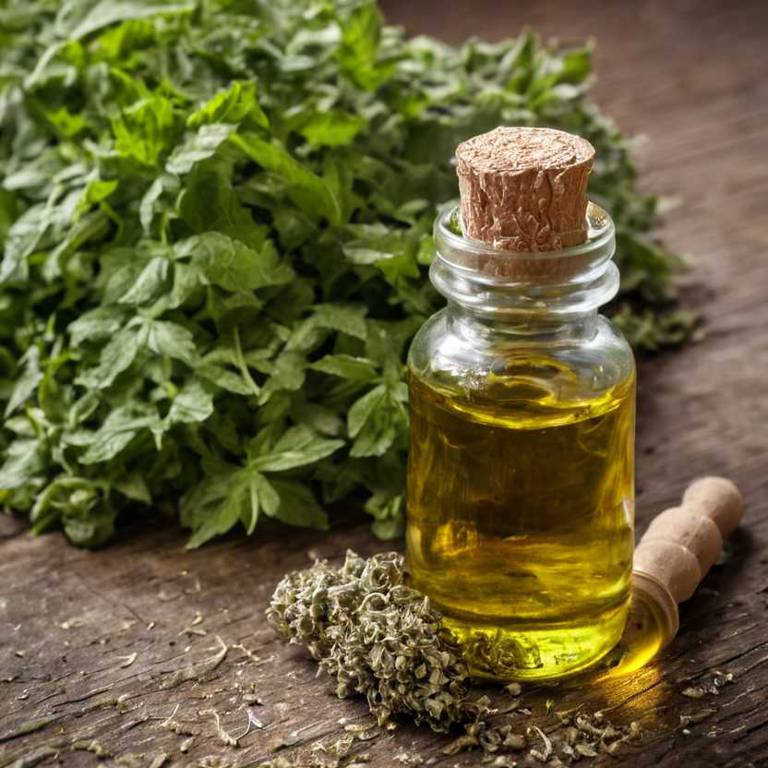
Herbal tinctures for cracked heels are concentrated plant extracts that have been traditionally used to soothe and heal dry, cracked skin on the feet.
These tinctures work by providing intense moisture and nourishment to the affected area, helping to repair damaged tissue and promote healthy skin regeneration. Examples of herbal tinctures that help with cracked heels include tea tree oil, aloe vera, and chamomile, which have anti-inflammatory and antiseptic properties.
By using these tinctures, people can experience relief from pain, discomfort, and embarrassment caused by cracked heels, allowing them to feel more confident and comfortable in their own skin.
The following article describes in detail the most important tinctures for cracked heels, including medicinal properties, parts of herbs to use, and recipes for preparations.
- 1. Aloe vera
- 2. Urtica dioica
- 3. Calendula officinalis
- 4. Melaleuca alternifolia
- 5. Artemisia absinthium
- 6. Hypericum perforatum
- 7. Taraxacum officinale
- 8. Echinacea angustifolia
- 9. Lavandula angustifolia
- 10. Camellia sinensis
- What is the best combination of herbal tinctures to use for cracked heels?
- What ailments similar to cracked heels are treated with herbal tinctures?
1. Aloe vera
Aloe tinctures helps with cracked heels because of its potent anti-inflammatory and soothing properties.
The aloe vera gel penetrates deep into the skin, providing long-lasting hydration and moisturizing dry, cracked heels. It also contains vitamins A, C, and E, which help to stimulate collagen production, promoting healthy skin cell growth.
As a result, cracked heels begin to soften, smooth out, and become less prone to further cracking, leaving feet feeling soft, supple, and rejuvenated.
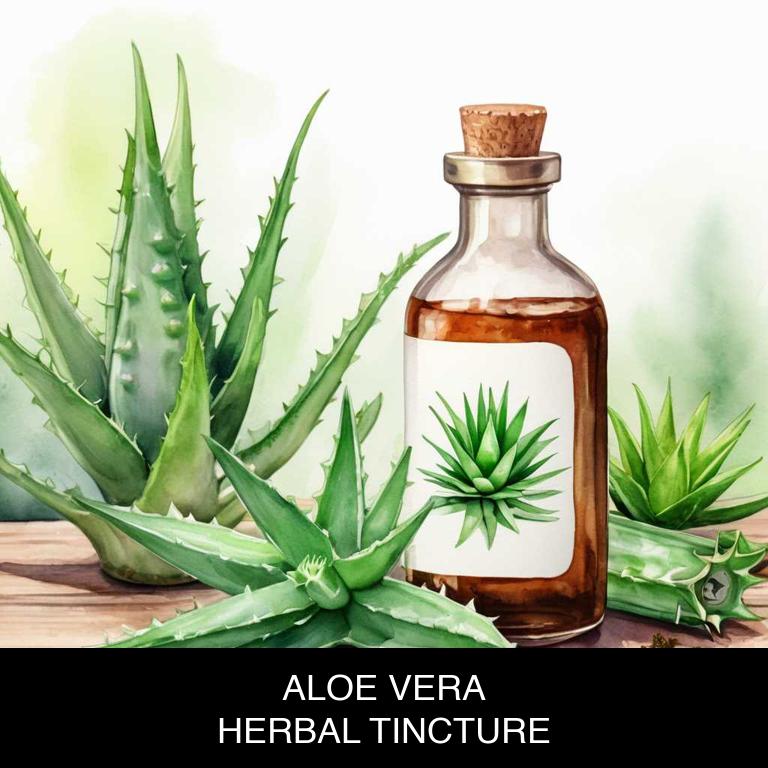
Medicinal Constituents
The list below shows the primary medicinal constituents in Aloe vera tinctures that help with cracked heels.
- Acemannan: Acemannan, a polysaccharide, helps to accelerate wound healing, reduce inflammation, and promote tissue repair, ultimately contributing to the improvement of cracked heels.
- Vitamins c and e: Vitamins C and E, present as phenolics in Aloe vera, act as antioxidants, protecting the skin from damage caused by free radicals, which can contribute to the development and exacerbation of cracked heels.
- Glucomannans: Glucomannans, another type of polysaccharide in Aloe vera, help to retain moisture in the skin, reducing dryness and promoting hydration, which is essential for healing and preventing cracked heels.
Parts Used
The list below shows the primary parts of aloe used to make tinctures for cracked heels.
- Leaves: The leaves of Aloe vera contain the highest concentration of aloe vera gel, which is rich in moisturizing compounds that help to soften and heal cracked heels.
- Seeds: Aloe vera seeds are known to have anti-inflammatory properties that can help to reduce swelling and soothe dry skin on cracked heels.
- Flowers: Aloe vera flowers contain flavonoids and other compounds that have antioxidant and anti-inflammatory properties, which can help to protect and soothe dry, cracked skin on the heels.
Quick Recipe
The following recipe gives a procedure to make a basic aloe for cracked heels.
- Harvest fresh aloe vera leaves when they are mature and the gel inside is clear and plentiful.
- Slice the aloe vera leaves into small pieces and weigh out 1 pound of the gel.
- Steep the aloe vera gel in 4 cups of 80 proof vodka in a clean glass jar for 2 weeks.
- Strain the liquid mixture through a cheesecloth or coffee filter into a separate container discard the solids.
- Transfer the herbal aloe vera tincture to dark glass bottles and store in a cool dry place for 6 months.
2. Urtica dioica
Stinging nettle tinctures helps with cracked heels because of its remarkable anti-inflammatory and antioxidant properties.
The tincture's ability to reduce inflammation in the skin helps to soothe and calm irritated areas, making it an effective treatment for dry, flaky, and cracked heels. Additionally, stinging nettle's antioxidant properties help to nourish and moisturize the skin, promoting healthy cell growth and regeneration.
As a result, regular use of herbal stinging nettle tinctures can lead to improved skin hydration, elasticity, and overall appearance of healthier-looking heels.
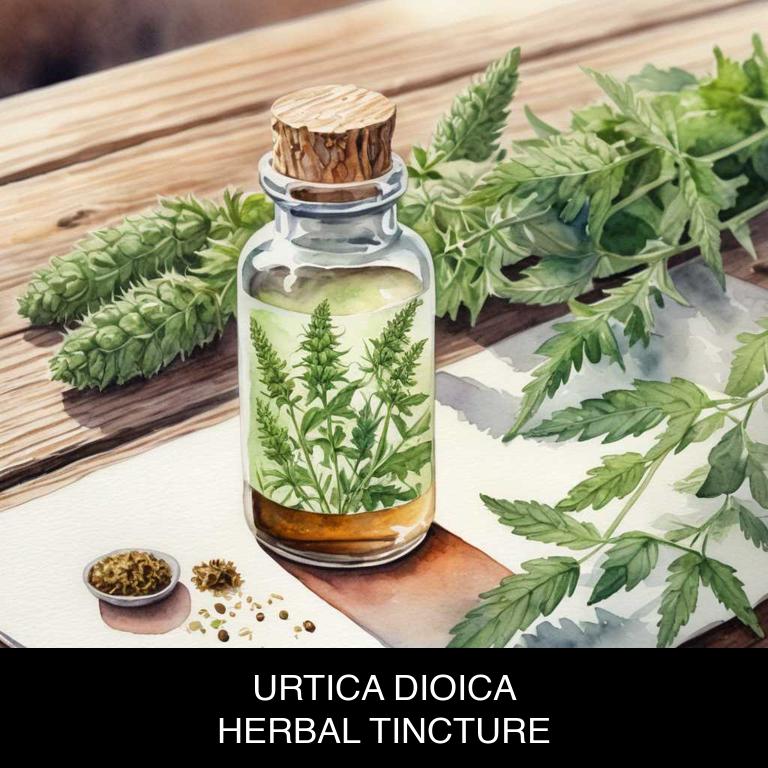
Medicinal Constituents
The list below shows the primary medicinal constituents in Urtica dioica tinctures that help with cracked heels.
- Alkylamides: These compounds have anti-inflammatory properties, which can help reduce the redness and swelling associated with cracked heels.
- Iridoid glycosides: These compounds exhibit antioxidant and anti-inflammatory activities, which can help protect the skin from damage, promote wound healing, and reduce inflammation in cracked heels.
- Flavonoids: These compounds have anti-inflammatory and antioxidant properties, which can help reduce inflammation, promote collagen production, and improve skin elasticity, ultimately contributing to healthier and more resilient skin on the heels.
Parts Used
The list below shows the primary parts of stinging nettle used to make tinctures for cracked heels.
- Leaves: The leaves are rich in antioxidants and have anti-inflammatory properties that help to soothe and moisturize dry, cracked skin on the heels.
- Roots: The roots of Urtica dioica contain a high concentration of allantoin, which helps to break down dead skin cells and promote healing in cracked skin.
- Stems: The stems of the plant contain compounds that help to reduce inflammation and promote collagen production, which can aid in the repair of cracked skin on the heels.
Quick Recipe
The following recipe gives a procedure to make a basic stinging nettle for cracked heels.
- Harvest the urtica dioica leaves and stems in the spring when they are at their most potent and fresh.
- Chop the harvested urtica dioica plant material into small pieces to release its medicinal properties.
- Combine the chopped urtica dioica plant material with 60-80% high-proof ethanol in a clean glass jar.
- Store the jar in a cool dark place for 2-6 weeks to allow the plant material to infuse into the ethanol.
- Strain the mixture through a cheesecloth or a coffee filter into a clean glass bottle to separate the liquid tincture from the solids.
3. Calendula officinalis
Pot marigold tinctures helps with cracked heels because it contains powerful antioxidants and anti-inflammatory compounds that soothe and hydrate dry, damaged skin.
The tincture's ability to penetrate deep into the skin provides intense moisture, reducing flaking and cracking while promoting healthy skin regeneration.
Additionally, its antimicrobial properties help combat fungal and bacterial infections that can contribute to cracked heels, leaving feet feeling soft, smooth, and rejuvenated.

Medicinal Constituents
The list below shows the primary medicinal constituents in Calendula officinalis tinctures that help with cracked heels.
- Triterpenoids: These compounds help to promote wound healing and tissue repair, which can aid in reducing the severity of cracked heels by facilitating the regeneration of skin cells.
- Flavonoids: These polyphenolic compounds exhibit anti-inflammatory properties, which can help to reduce redness, swelling, and pain associated with cracked heels, promoting a more comfortable and healthy skin environment.
- Sesquiterpenes: These compounds have been found to possess antimicrobial properties, which can help to prevent infection and promote a clean environment for skin healing, reducing the risk of cracked heels becoming severely infected.
Parts Used
The list below shows the primary parts of pot marigold used to make tinctures for cracked heels.
- Flowers: They are the primary part used due to their high concentration of flavonoids and triterpenoids, which have anti-inflammatory and healing properties.
- Leaves: They are used in some cases to make tinctures, particularly when flowers are not available, as they contain similar compounds that aid in skin regeneration.
- Seeds: They are sometimes used to make tinctures, but less commonly than flowers or leaves, as they have a lower concentration of beneficial compounds for skin health.
Quick Recipe
The following recipe gives a procedure to make a basic pot marigold for cracked heels.
- Gather 1 part of dried calendula officinalis flowers and 2 parts of vodka in a clean glass jar.
- Steep the mixture in a cool dark place for 2-6 weeks with occasional shaking.
- Strain the liquid through a cheesecloth into another clean glass container discarding the solids.
- Add a small amount of glycerin to the tincture to enhance its shelf life and stability.
- Transfer the tincture to dark glass bottles and store them in a cool dark place for up to 2 years.
4. Melaleuca alternifolia
Tea tree tinctures helps with cracked heels because of its remarkable antiseptic and anti-inflammatory properties.
The oil, derived from the leaves of Melaleuca alternifolia, has natural antibacterial compounds that target bacteria and fungi that thrive on dry, cracked skin. When applied topically to affected areas, tea tree tincture can reduce inflammation, prevent infection, and promote healthy healing.
Its antifungal properties also help combat fungal infections, such as athlete's foot, which often accompany cracked heels.
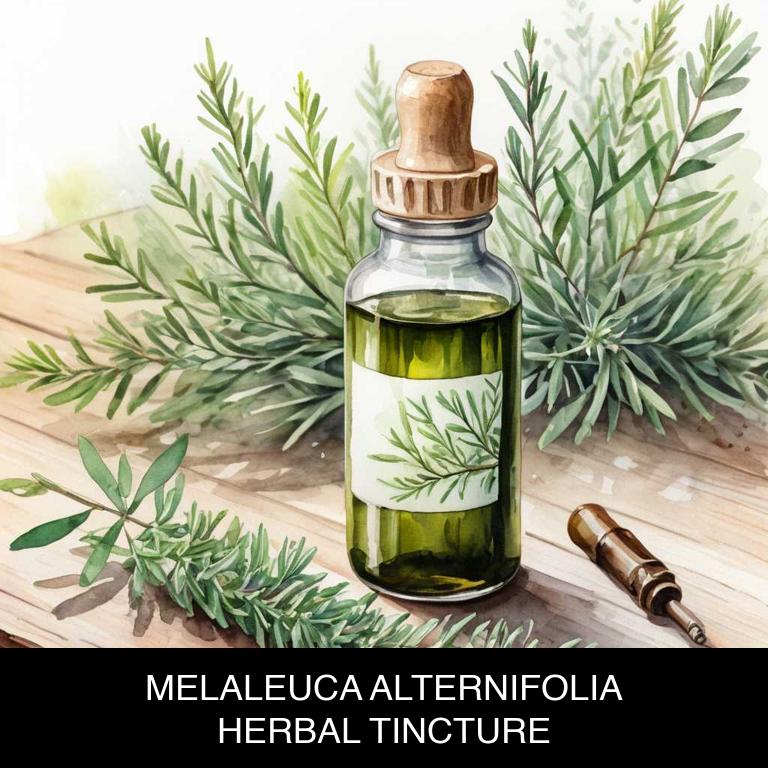
Medicinal Constituents
The list below shows the primary medicinal constituents in Melaleuca alternifolia tinctures that help with cracked heels.
- Cineole: This terpene helps with cracked heels by providing antimicrobial and anti-inflammatory properties, which aid in wound healing and reducing infection.
- Caryophyllene: This sesquiterpene has anti-inflammatory and antioxidant properties that help reduce inflammation and promote tissue repair in cracked heels.
- Terpinen-4-ol: This terpene exhibits antimicrobial and antifungal properties, which help combat fungal infections commonly associated with cracked heels, promoting a healthy skin environment.
Parts Used
The list below shows the primary parts of tea tree used to make tinctures for cracked heels.
- Leaves: Leaves are widely used due to their high concentration of tea tree oil, which has antimicrobial and antifungal properties that help to soothe and heal cracked heels.
- Barks: Barks are used for their astringent properties, which can help to dry out and reduce the appearance of cracked heels.
- Roots: Roots are utilized for their anti-inflammatory properties, which can help to reduce redness and swelling associated with cracked heels.
Quick Recipe
The following recipe gives a procedure to make a basic tea tree for cracked heels.
- Harvest 10-20 fresh melaleuca alternifolia leaves and flowers in the early morning to preserve their potency.
- Chop the harvested leaves and flowers into small pieces to release their essential oils and properties.
- Combine the chopped plant material with 80% ethanol in a 1:3 ratio by weight for tincture preparation.
- Steep the plant material in the ethanol mixture for 2-3 weeks in a cool dark place shaking daily.
- Strain the tincture through a cheesecloth and transfer it to a clean glass bottle for storage.
5. Artemisia absinthium
Wormwood tinctures helps with cracked heels because of its antiseptic, anti-inflammatory, and moisturizing properties.
The tannins present in wormwood help to dry out any excess moisture that can exacerbate cracks, while the antioxidants promote healing and reduce inflammation. Additionally, the herbal extract has natural astringent properties that help to tighten and tone the skin, reducing the appearance of deep cracks and promoting healthy skin regeneration.
Overall, using a wormwood tincture on cracked heels can provide relief from discomfort and promote faster recovery.
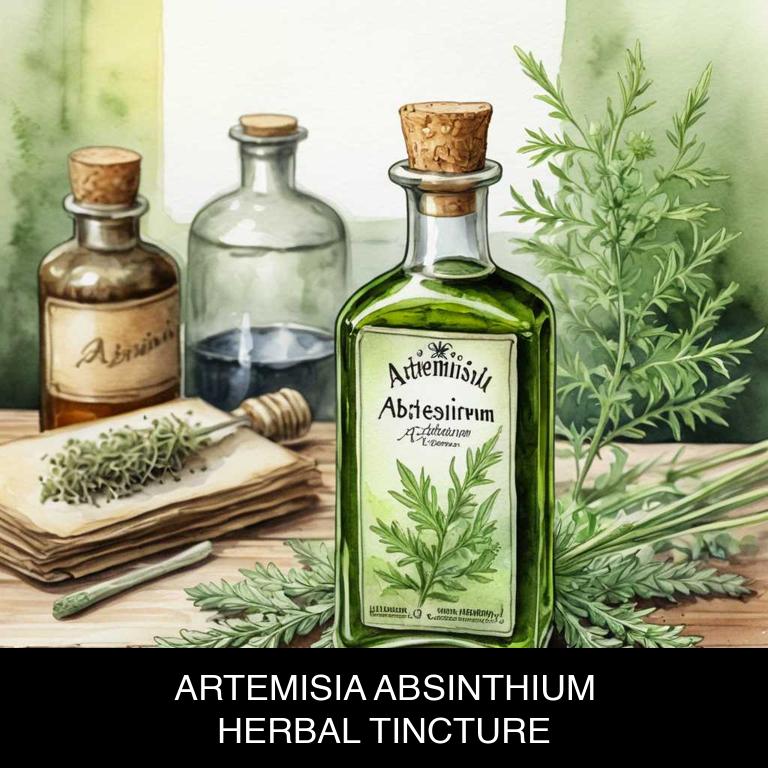
Medicinal Constituents
The list below shows the primary medicinal constituents in Artemisia absinthium tinctures that help with cracked heels.
- Thujone: Thujone has anti-inflammatory and antiseptic properties, which can help reduce inflammation and promote healing of cracked skin.
- Volatile oils: These oils have antimicrobial properties, which can help prevent infections and promote a healthy environment for skin healing.
- Tannins: Tannins have astringent properties, which can help reduce moisture loss from the skin, promote wound healing, and reduce the appearance of cracked skin.
Parts Used
The list below shows the primary parts of wormwood used to make tinctures for cracked heels.
- Leaves: They are rich in antioxidants and have anti-inflammatory properties, which may help soothe and moisturize dry, cracked skin.
- Stems: They contain bioactive compounds that may help to stimulate blood flow and promote the healing of damaged skin.
- Roots: They have been traditionally used in herbal remedies to treat skin issues, including cracked heels, due to their purported anti-inflammatory and antiseptic properties.
Quick Recipe
The following recipe gives a procedure to make a basic wormwood for cracked heels.
- Harvest the absinthium flowers and leaves at dawn to ensure peak potency and minimal moisture content.
- Dry the plant material in a warm dark place for 1-2 weeks to remove excess moisture.
- Combine 1 part of dried absinthium plant material with 5 parts of 95% ethanol in a clean glass jar.
- Store the mixture in a cool dark place for 2-6 weeks to allow for steeping and extraction.
- Strain and filter the liquid mixture through a cheesecloth and glass jar to remove solids and debris.
6. Hypericum perforatum
St john's wort tinctures helps with cracked heels because of its anti-inflammatory and antiseptic properties, which soothe and calm irritated skin.
The tincture's ability to stimulate blood flow also promotes healing and regeneration of new skin cells, reducing the appearance of cracks and fissures. Additionally, St John's Wort has antimicrobial properties that prevent bacterial and fungal infections that can exacerbate cracked heels, allowing for a more effective recovery.
Regular use of St John's Wort tincture can lead to healthier, smoother skin on the feet.
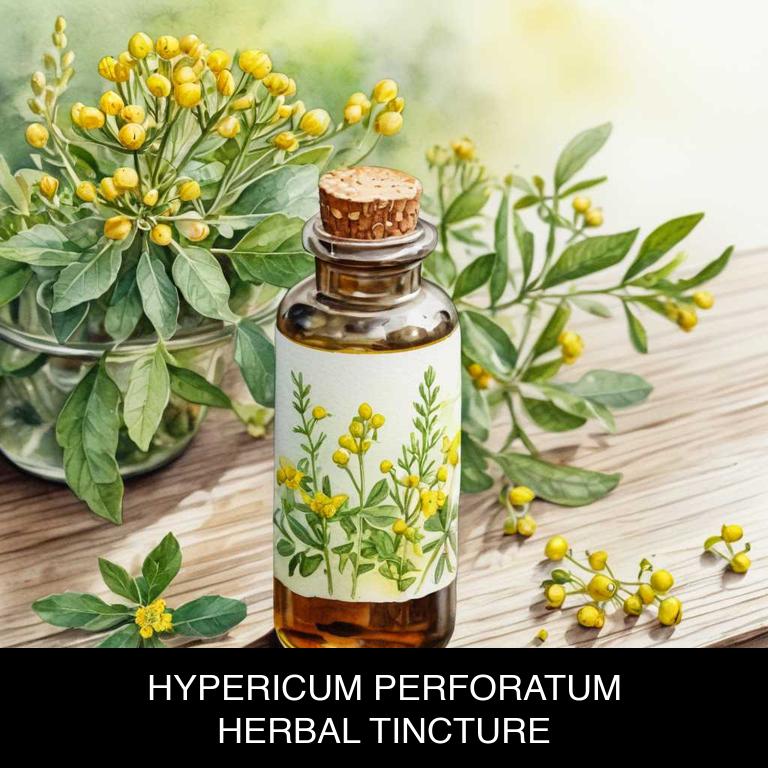
Medicinal Constituents
The list below shows the primary medicinal constituents in Hypericum perforatum tinctures that help with cracked heels.
- Naphthodianthrones: These compounds, particularly hyperforin and adhyperforin, have anti-inflammatory and antiseptic properties, which can help soothe and protect cracked heels from infection and further damage.
- Flavonoids: Flavonoids like quercetin and kaempferol in Hypericum perforatum tinctures have antioxidant and anti-inflammatory properties, which can help reduce inflammation, promote wound healing, and protect the skin from further damage.
- Phenolic acids: Phenolic acids such as rosmarinic acid in Hypericum perforatum tinctures have antioxidant and anti-inflammatory properties, which can help reduce inflammation, promote wound healing, and protect the skin from further damage, ultimately contributing to the healing of cracked heels.
Parts Used
The list below shows the primary parts of st john's wort used to make tinctures for cracked heels.
- Leaves: Known for their anti-inflammatory and antimicrobial properties, which help soothe and heal cracked skin.
- Flowers: Rich in flavonoids and other compounds that promote tissue repair, reduce inflammation, and protect the skin from damage.
- Roots: Contain bioactive compounds that have antiseptic and anti-inflammatory effects, which aid in wound healing and skin regeneration.
Quick Recipe
The following recipe gives a procedure to make a basic st john's wort for cracked heels.
- Harvest 30-40 grams of fresh hypericum perforatum flowers and leaves on a dry sunny morning.
- Dry the harvested plant material in a dark place at 35-40 degrees celsius for 24 hours.
- Chop 100 grams of the dried plant material into small pieces to increase surface area.
- Combine the chopped plant material with 700 milliliters of 50% ethanol in a clean glass jar.
- Steep the mixture for two weeks in a cool dark place then strain and discard the solids.
7. Taraxacum officinale
Dandelion tinctures helps with cracked heels because of its potent anti-inflammatory properties, which soothe and calm dry, irritated skin.
The tannins in dandelion root also help to tighten and strengthen the skin's natural barrier, reducing moisture loss and preventing further cracking. Additionally, dandelion's antioxidant compounds work to combat free radicals that can contribute to skin damage and aging, leaving heels feeling softer, smoother, and more hydrated.
With regular use, cracked heels can begin to heal and repair themselves, leaving feet looking and feeling healthier overall.
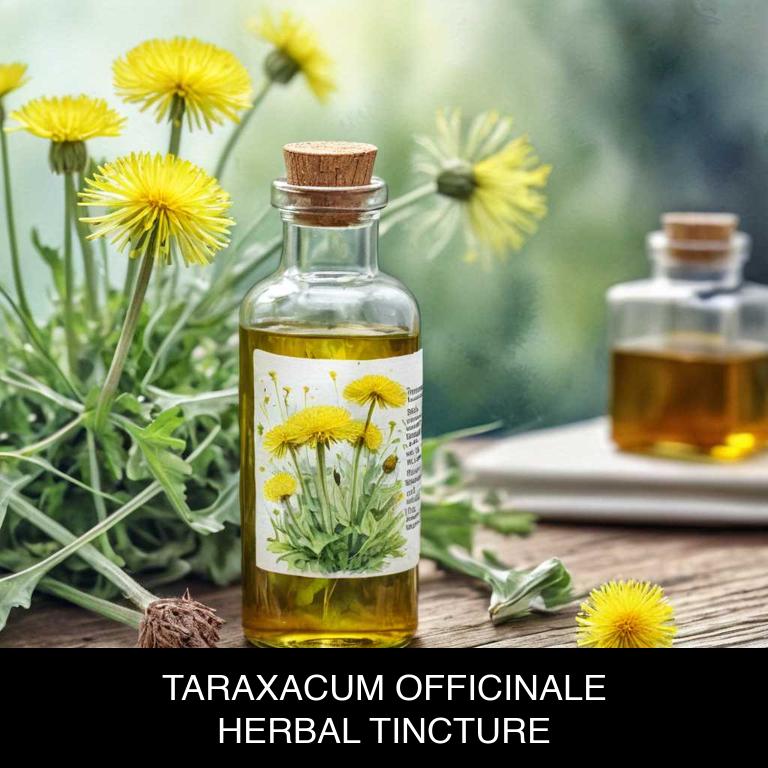
Medicinal Constituents
The list below shows the primary medicinal constituents in Taraxacum officinale tinctures that help with cracked heels.
- Flavonoids: Flavonoids, such as quercetin and kaempferol, found in Taraxacum officinale tinctures, help to improve skin elasticity and reduce inflammation, which can contribute to cracked heels.
- Polysaccharides: Polysaccharides, like arabinose and galactose, in Taraxacum officinale tinctures, possess moisturizing and protective properties, helping to soothe and hydrate dry, cracked skin.
- Saponins: Saponins, such as taraxasterol, found in Taraxacum officinale tinctures, exhibit anti-inflammatory and antimicrobial properties, which can help to prevent infection and promote healing of cracked heels.
Parts Used
The list below shows the primary parts of dandelion used to make tinctures for cracked heels.
- Roots: They are used because they contain inulin, a natural humectant that helps to lock in moisture and soothe dry, cracked skin.
- Leaves: They are used because they contain flavonoids and phenolic acids that have anti-inflammatory and antioxidant properties, which can help to reduce inflammation and promote healing in cracked heels.
- Flowers: They are used because they contain taraxasterol, a triterpene that has anti-inflammatory and antiseptic properties, which can help to reduce inflammation and prevent infection in cracked heels.
Quick Recipe
The following recipe gives a procedure to make a basic dandelion for cracked heels.
- Harvest fresh taraxacum officinale roots and leaves in the morning after the dew has evaporated.
- Chop 100g of taraxacum officinale roots and leaves into small pieces using a sharp knife.
- Combine chopped taraxacum officinale with 500ml of 35-40% ethanol in a clean glass jar.
- Steep the mixture for 2-3 weeks in a cool dark place with occasional shaking every day.
- Strain the liquid through a cheesecloth or coffee filter into a clean glass bottle discard solids.
8. Echinacea angustifolia
Kansas coneflower tinctures helps with cracked heels because of its remarkable anti-inflammatory and antibacterial properties.
The extract from the plant, Echinacea pallida, is rich in antioxidants that soothe and calm dry, irritated skin, reducing inflammation and redness associated with cracked heels. Additionally, its antimicrobial properties help combat fungal and bacterial infections that can exacerbate the condition.
By applying a Kansas coneflower tincture to affected areas, individuals can experience relief from discomfort, pain, and appearance of cracked heels, promoting healthy, soft skin.
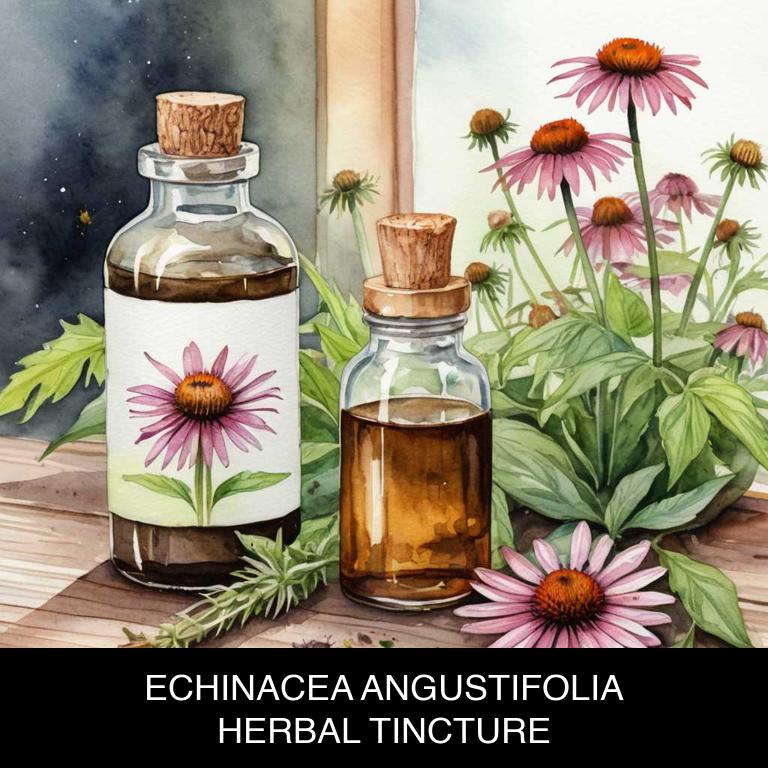
Medicinal Constituents
The list below shows the primary medicinal constituents in Echinacea angustifolia tinctures that help with cracked heels.
- Iridoid glycosides: These compounds, particularly echinacoside, may help soothe and moisturize dry, cracked skin, promoting healing and reducing inflammation.
- Phenolic acids: Flavonoids and phenolic acids present in Echinacea angustifolia, such as kaempferol and quercetin, may have antioxidant and anti-inflammatory properties that help protect the skin from damage, reduce inflammation, and promote tissue repair.
- Caffeic acid: This phenolic compound may have antimicrobial and anti-inflammatory effects, which can help prevent infections and promote wound healing in cracked heels.
Parts Used
The list below shows the primary parts of kansas coneflower used to make tinctures for cracked heels.
- Roots: They are the primary part used due to their high concentration of echinacoside, which is believed to promote skin health and wound healing.
- Stems: Stems are used for their secondary metabolites, which are thought to possess anti-inflammatory properties that can help soothe and protect dry, cracked skin.
- Leaves: Leaves are used for their rich content of flavonoids, which are believed to have antioxidant properties that can help reduce inflammation and promote skin regeneration.
Quick Recipe
The following recipe gives a procedure to make a basic kansas coneflower for cracked heels.
- Gather 1 part of dried echinacea angustifolia roots and 2 parts of dried leaves in a large bowl.
- Combine the dried echinacea roots and leaves in a glass jar and add 80-proof vodka to cover them completely.
- Seal the jar and allow the mixture to steep in a cool dark place for 2 to 4 weeks.
- Strain the tincture through a cheesecloth or a coffee filter into another glass jar discarding the solids.
- Transfer the tincture to small dark glass bottles and store them in a cool dark place for up to 2 years.
9. Lavandula angustifolia
English lavender tinctures helps with cracked heels because of its soothing and moisturizing properties.
The herb contains flavonoids, which have anti-inflammatory and antioxidant effects that calm irritation and reduce swelling around the cracked areas. Additionally, lavender's antiseptic and antibacterial properties help to prevent infection and promote healthy skin regeneration.
By applying a few drops of lavender tincture to the affected area, you can experience relief from dryness, discomfort, and pain associated with cracked heels.

Medicinal Constituents
The list below shows the primary medicinal constituents in Lavandula angustifolia tinctures that help with cracked heels.
- Linalool: A terpene that helps with cracked heels by promoting skin hydration and reducing inflammation, which can contribute to the dryness and irritation associated with cracked skin.
- Lavandulol: A terpene that has antimicrobial properties, helping to prevent infections and promote wound healing, which can aid in the recovery of cracked skin.
- Lavandulyl acetate: A sesquiterpene that has antioxidant properties, helping to protect the skin from oxidative stress and damage caused by free radicals, which can contribute to skin dryness and irritation.
Parts Used
The list below shows the primary parts of english lavender used to make tinctures for cracked heels.
- Leaves: Leaves are used because they contain antioxidants and anti-inflammatory compounds that help soothe and heal dry, cracked skin.
- Flowers: Flowers are used because they have antiseptic and antifungal properties that help prevent infections in cracked heels and promote wound healing.
- Stems: Stems are used because they contain flavonoids and terpenes that help reduce inflammation and promote skin regeneration in cracked heels.
Quick Recipe
The following recipe gives a procedure to make a basic english lavender for cracked heels.
- Harvest 100g of fresh lavandula angustifolia flowers in the early morning to capture optimal oil content.
- Dry the harvested flowers in a warm dark place for 7-10 days to remove moisture.
- Combine 100g of dried flowers with 750ml of 80% ethanol in a clean glass jar.
- Steep the mixture in a cool dark place for 2-3 weeks, shaking the jar daily.
- Strain the liquid through a cheesecloth into a clean glass bottle, discarding the solids.
10. Camellia sinensis
Tea tinctures helps with cracked heels because they provide an intense dose of nourishing compounds that penetrate deep into the skin.
The antioxidants, vitamins, and minerals in herbal tea tinctures help to soften and moisturize dry, rough skin, reducing cracks and fissures. Additionally, many herbs such as aloe vera, chamomile, and calendula have anti-inflammatory properties that soothe irritated skin and promote healthy healing.
This results in smoother, healthier-looking heels with minimal cracking and discomfort.
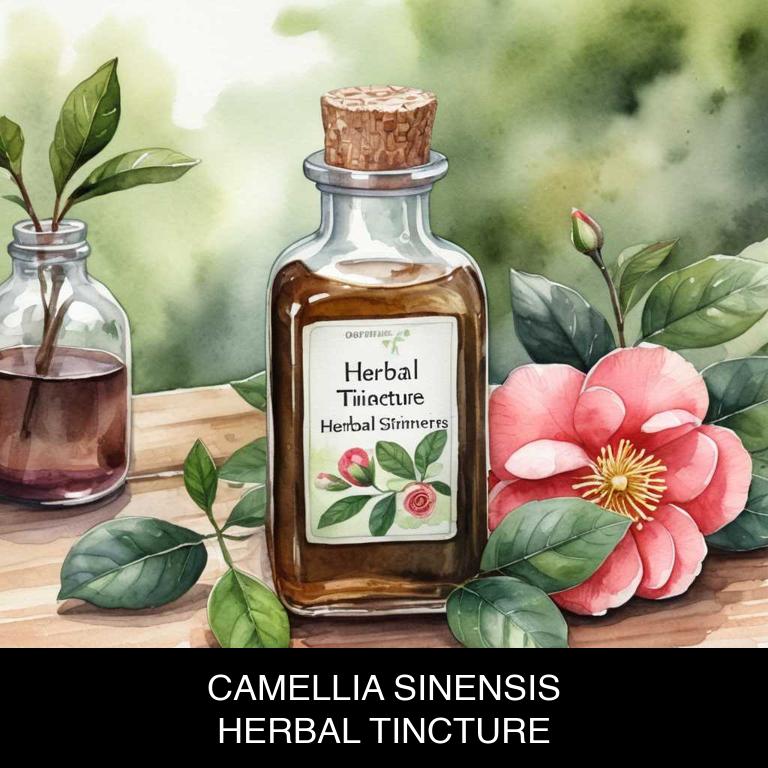
Medicinal Constituents
The list below shows the primary medicinal constituents in Camellia sinensis tinctures that help with cracked heels.
- Catechins: These polyphenolic compounds help protect the skin from damage by reducing inflammation and promoting collagen production, which can help to heal and repair cracked heels.
- Theaflavins: These flavonoids have antioxidant and anti-inflammatory properties, which can help to soothe and calm the skin, reducing the appearance of cracked heels and promoting healthy skin regeneration.
- Quercetin: As a flavonoid with anti-inflammatory properties, quercetin can help to reduce inflammation and promote wound healing, making it beneficial for treating and preventing cracked heels.
Parts Used
The list below shows the primary parts of tea used to make tinctures for cracked heels.
- Leaves: They contain antioxidants and polyphenols that may help to soothe and protect the skin.
- Stems: They contain flavonoids and other compounds that may help to reduce inflammation and promote healing.
- Roots: They contain alkaloids and other compounds that may help to stimulate blood flow and promote skin regeneration.
Quick Recipe
The following recipe gives a procedure to make a basic tea for cracked heels.
- Harvest 1 cup of fresh camellia sinensis leaves from the plant and dry them thoroughly to prevent spoilage.
- Combine the dried leaves with 2 cups of vodka in a clean glass jar to create a 1:2 ratio mixture.
- Steep the mixture in a cool dark place for 2-6 weeks to allow the tincture to mature.
- Strain the liquid through a cheesecloth or a coffee filter into another clean glass jar to remove solids.
- Store the camellia sinensis tincture in a cool dark place for up to 2 years before using it.
What is the best combination of herbal tinctures to use for cracked heels?
The best combination of herbal tinctures that help with cracked heels is a blend of comfrey, aloe vera, and tea tree oil.
Comfrey tincture promotes collagen production and skin regeneration, while aloe vera tincture soothes and moisturizes dry skin. Tea tree oil, with its antimicrobial properties, helps prevent infection and speeds up the healing process. This trio not only reduces dryness and flakiness but also supports the natural repair of damaged skin, ultimately leading to healthier and more radiant heels.
Regular application can provide long-lasting results.
What ailments similar to cracked heels are treated with herbal tinctures?
Ailments similar to cracked heels that are treated with herbal tinctures are various skin conditions, such as eczema, psoriasis, and dermatitis.
Herbal tinctures like calendula, chamomile, and lavender are used to soothe and calm irritated skin, reducing inflammation and promoting healing.
Other ailments, like athlete's foot and fungal infections, can also be treated with herbal tinctures containing antifungal properties from plants like tea tree and oregano.